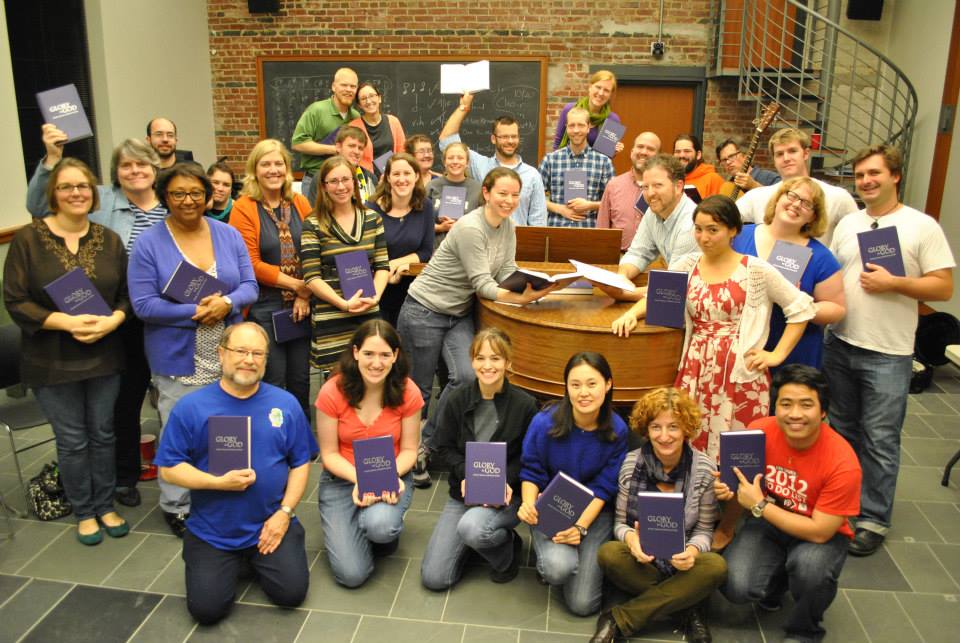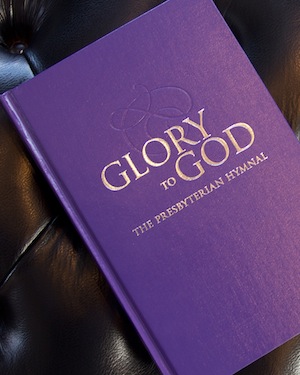
When I was in fifth grade, my mom became the director of Christian Education at my home church. Consequently, before I learned to drive, I spent many hours at church waiting until it was time to go home. As it was before the age of smart phones – and because I often forgot to bring something to read – I often entertained myself by sitting down at the piano and singing through the hymnal. Over the years I spent countless hours flipping through that blue 1990 Presbyterian Hymnal, and I sang from it every Sunday in corporate worship. It was through those melodies and lyrics that my faith was shaped, challenged, and nourished.
Thus, it was with great anticipation that I began to turn the pages of the “new purple hymnal” several weeks ago. Upon first glance, I saw songs that I recognized, and I rejoiced that they had been carried over from the 1990 hymnal. I saw songs I had sung joyfully at various Presbyterian worship gatherings over the years, and I celebrated finally seeing them in print. Yet, I also saw titles and tunes that caught my eye and – as a final-level seminarian – set off my ‘hermeneutic of suspicion.’ On the page opposite the old favorite “Come, Thou Almighty King” (#2) is a hymn called “Womb of Life and Source of Being” (#3). Immediately preceding “Eternal Father, Strong to Save” (#8) is a song entitled “Mothering God, You Gave Me Birth” (#7). What’s up with all this gendered language for God?
So, I kept turning the pages of the hymnal. All the way to page 928, where the Presbyterian Committee on Congregational Song – the group that created the new hymnal – included A Statement on Language, ratified in October 2009. That beautiful and descriptive theological statement about their vision of the hymnal’s language includes a significant portion addressing the language used for God:
“A commitment to inclusive language for the people of God reflects the consensus of the church. When it comes to use of language for God, however, the conversation is still ongoing. While many are deeply nurtured and comforted by traditional imagery for God, many others are concerned about associations of patriarchy and other forms of domination and are looking for other and more diverse language… The collection will emphasize that the God who meets us so graciously and intimately in salvation history is at the same time one who is wholly other and beyond gender. Therefore, texts will reflect a strong preference for avoiding the use of male pronouns for God. In evaluating each hymn or song, issues of tradition, theological integrity, poetic quality, and copyright will all be considered. The goal is a collection in which traditional hymns and songs are balanced with others that are more gender-neutral or expansive in their reference to God.[1]
___________________________________________
Gendered language about God is ultimately a reflection of what we as a Church believe about human beings.
___________________________________________
Instead of doing back-flips to remove any and all gendered language for God, Glory to God intentionally recognizes, perhaps even celebrates, the gendered language that humans use for God, and it makes room for female and male imagery. In the words of the committee, when gender-neutral language was not feasible, expansion rather than contraction was sought. The idea of “inclusive language” has been expanded in light of the recognition that much of our language about God is gendered. The ancient Hebrew and Greek of our Scriptures overwhelmingly use male pronouns for God; it’s next to impossible, perhaps even unnatural to completely gender-neutralize our English-language understanding of God. Thus, for Glory to God, to be inclusive means to instead incorporate our understandings of God and of ourselves in a way that does not elevate one gender over the other as superior and more “God-like.” It recognizes that while God is beyond gender, we as human beings are gendered and use language that is. Glory to God’s incorporation of both male and female imagery for God seeks to allow inclusion in the midst of exclusive language; it allows us to celebrate in song that God is our Creator while also affirming God as our Father and God as our Mother.

The words that we sing about God have an impact on our understanding of God, our understanding of the world, and our understanding of ourselves. If we use only male pronouns and imagery for God, we sing of a world that equates male-ness with divinity. We ignore the maternal language and imagery for God that we find in our very Scriptures. The hymn writers have striven to be as gender-neutral as possible, but as their statement acknowledges, gender-neutral language is not always feasible. We are human beings who speak a human language about our divine God, and our language forces us to make choices about how we will refer to God. The hymn committee recognizes this and has seized this opportunity as a moment of transformation for our hymnody – a moment of expanding the way that we view God, the world, and ourselves. The language of these hymns is effectively an avenue through which to sing gender justice into being.
Yet, the hymn writers have taken a risk. Most of the more familiar hymns that employ gendered-language describe God with masculine, paternal imagery. The unfamiliar hymns describing God in feminine and maternal ways might seem all too much for some congregations – both for their melodies and for their lyrics. Some of the newer hymns incorporating female imagery seem overly functional and – to put it harshly – not as poetically rich as their counterparts. The reality is that congregations are not required to sing the newer hymns with divine female imagery, and some may choose to continue singing about God the Father without ever mentioning God the Mother. Even yet, as one opens the hymnal to sing “Come, Thou Almighty King,” he or she cannot help but see “Womb of Life and Source of Being” on the opposing page. Even if the latter song is not sung, it is visibly present as one holds the hymnal to sing. Whether or not all of the varied gendered songs about God are sung (and hopefully they will be!), their very presence in the hymnal affirms our ever-expanding understanding of God and our ever-expanding understanding of humanity.
___________________________________________
In a world where sexism continues to be an issue – and one from which the church is not immune – empowering women to see themselves as created in the image of God remains a vitally important ministry.
___________________________________________
Gendered language about God is ultimately a reflection of what we as a Church believe about human beings. The Presbyterian Church (USA) continues to explore what it means to be a child of God and how the Spirit moves across socially constructed boundaries and calls to human beings of all kinds. Many of these hymns sing of a day to come – a day of social justice in which God’s Kingdom reaches across all these divisions. I rejoiced to see “For Everyone Born” (#769) included in this collection. The second verse of this hymn focuses specifically on gender justice, reading: “For woman and man, a place at the table, revising the roles, deciding the share, with wisdom and grace, dividing the power, for woman and man, a system that’s fair.” Glory to God affirms what the PC(USA) as a whole affirms in our Confessional standards: that “The same Spirit who inspired the prophets and apostles… calls women and men to all ministries of the church.”[2] In a world where sexism continues to be an issue – and one from which the church is not immune – empowering women to see themselves as created in the image of God remains a vitally important ministry. For both women and men, singing songs that use female-gendered language for God might just be the turning point in expanding our understanding of God and of our fundamental equality with our fellow human beings.

Photo Credit Laura Kelly
At Union Presbyterian Seminary, we celebrated Glory to God with a vivacious hymn sing on the night before the hymnal’s formal dedication in community worship. After over two hours of singing, we had barely scratched the surface of the 800+ hymns. As I looked around the room that night, there were many smiling faces pouring over the contents of this book. In the 21st century, rarely do books garner such interest, but that book brought together our campus in a new and exciting way. We set aside our papers and our reading for an evening and gathered not as students, but as followers of Christ to sing our faith together – women and men – glorifying God with our voices, affirming together as one community what we believe.
[1] http://www.presbyterianhymnal.org/committeeStatements.html.
[2] A Brief Statement of Faith 10.4
AUTHOR BIO: Miriam Foltz is a final level M. Div. student at Union Presbyterian Seminary in Richmond, VA. A graduate of the College of William and Mary in Williamsburg, Virginia with a degree in Music & History, she served as a Young Adult Volunteer in Northern Ireland in 2010-2011 and is currently a candidate under care with the Presbytery of Giddings-Lovejoy. As she prepares for ministry, she is very thankful for the invaluable resource that is Glory to God!
***
More from Advent I: HOPE for Gender Justice.
Read more articles in this series.






Unbound Social